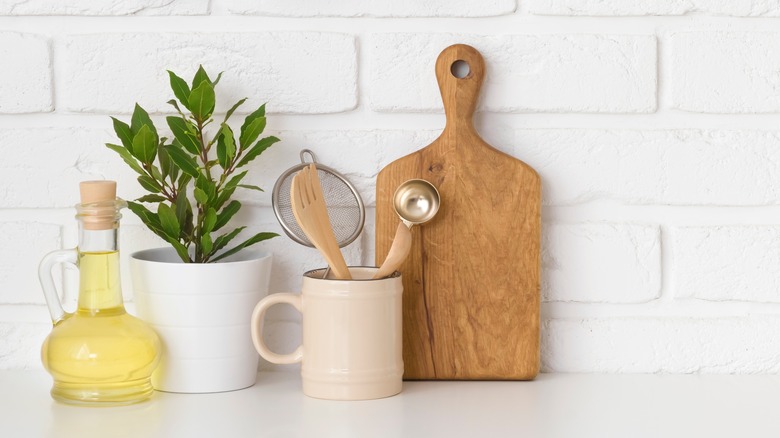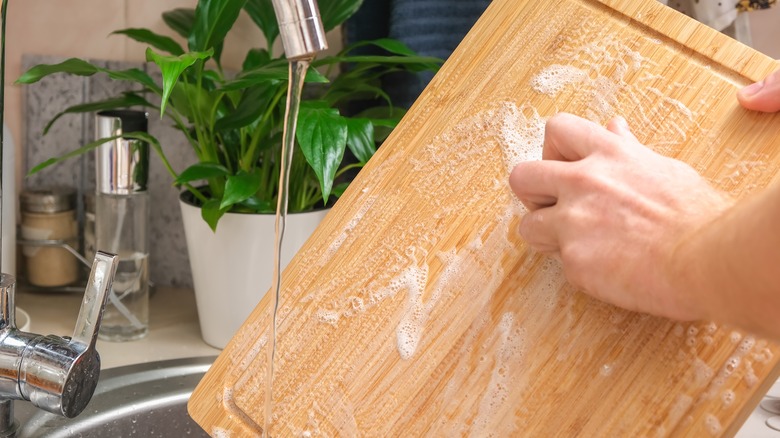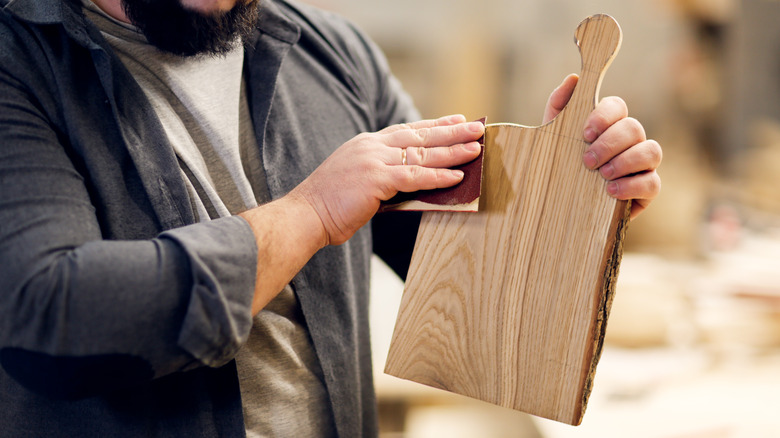Here's The Only Way You Should Store Cutting Boards
When you're finished washing and drying your cutting board, there's only one place in your kitchen where it belongs: propped up vertically and slightly angled so it doesn't lie flush against the wall. If you have more than one, make sure they're separated with a drying rack or other setup in which they have plenty of space to breathe. Not only will your well-cared-for board accessorize and beautify your kitchen, it'll also get the airflow it needs from all angles to stay dry and happy between uses.
It might seem more convenient to let your cutting board rest on your countertop, especially if you have a small kitchen with limited storage space. But when your board lies flat, there's likely to be moisture trapped between the bottom surface and your counter. Stacking your boards, too, can create a moisture trap. Over time, that excess moisture can create a breeding ground for bacteria, leading to lingering odors and potentially contaminating your ingredients the next time you cook. What's more, when your wooden board stays dry on one side and slightly damp on the other, the wood grains along the damp side can expand, causing the board to warp.
How to care for your cutting board
The key to keeping your cutting board in top condition is to clean it immediately after use. This means you'll need to wash and dry it after you're done cutting up your ingredients as part of your "clean as you go" routine. That way, stains and odors won't have a chance to settle into your board. Promptly washing is especially important for wooden boards to prevent moisture from seeping into the grain. A quick scrub with mild dish detergent, followed by a thorough rinse and dry, is all you need for daily upkeep. Never put a wooden cutting board through a dishwasher or allow it to soak — remember, a dry cutting board is a happy one. To speed up the cleaning process, protect your cutting board with parchment paper every time you work with messy foods.
About once a month, or anytime your board looks dried out, recondition it with mineral oil. Never use food-grade oil on your wooden cutting board — it will degrade and become rancid, making your board unsafe for use. Oil your cutting board generously, and prop it up or place it on a wire rack overnight so the oil can completely soak into the wood. In the morning, wipe off any excess oil. You can then add a coat of beeswax or board cream, which adds a protective moisture-repelling layer to the wood.
How to rejuvenate your cutting board
Whether you've been storing your cutting board improperly or it's starting to show signs of wear with regular use, you can revive it so it looks practically like new. Gently scrub away stains and neutralize odors by combining baking soda and water to make a paste. While you may be tempted to try cleaning your wood cutting board with lemon, the porous surface will absorb the acidic juice, potentially ruining the finish and corroding the wood, making it more vulnerable to damage in the long run. You can, however, use a lemon to clean and deodorize plastic cutting boards, as they're not as porous as wood.
A scratched cutting surface not only looks unappealing, but can harbor moisture and bacteria that may contaminate your food and shorten the lifespan of your board. For plastic cutting boards, you can try buffing out shallow scratches with a baking soda scrub, though when you start to notice deep cuts and stains that simply won't go away, it's time for a replacement. Plastic cutting boards should be replaced every year or so. Wooden chopping boards, meanwhile, can last a lifetime with proper care. You can sand down any rough edges and recondition the wood with mineral oil and beeswax. If your wooden board has sustained deep scratches, cracks, or severe warping, it's time to throw it out — or, better yet, let it live out its retirement as a trivet — and start fresh with a new one.



